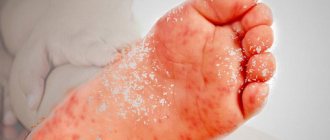How to distinguish chickenpox from allergies
Medical portal
- ENT diseases
- Stomach diseases
- Haemorrhoids
- Pancreatitis
- Weight loss
- Edema
- Skin diseases
- Gynecological diseases
- Joint diseases
- Urological diseases
- Allergy
- Lung diseases
- Thyroid diseases
- Parasites
- Prostatitis
- Blood diseases
- Hernias
- beauty
- Infertility
- Kidney diseases
- Vaccines
- Herpes
- Hypertension
- Childhood diseases
- Diabetes
- Migraine
- Injuries
Photo
How to distinguish chickenpox from allergies if the symptoms of these diseases are similar? This question is often asked by parents. A rash is a characteristic feature of allergic reactions. But not only. With diseases such as rubella, measles, chickenpox, this symptom also appears. In order to recognize what kind of disease lies beneath the rash, you need to know the characteristics of each of them.
Allergy or chickenpox - what's the difference?
For chickenpox to occur, it is necessary for a specific pathogen to penetrate the body - a virus that has an incomparable protein structure.
Herpes virus under a microscope
The allergic process is provoked by substances belonging to different classes of chemical compounds. These are not only proteins alien to the body (food or otherwise), but also substances of simple chemical composition (the class of fruit sugars), or even inorganic compounds, such as soot or ordinary sand - the main components of any dust.
Allergies are caused by allergens, most often food
The time for chickenpox rash to appear on the body is the period required for the virus to begin to multiply massively (about 14 days from the moment of infection). An allergic rash appears a few minutes (tens of minutes) after the substance penetrates the human body.
For the virus to exist, it must penetrate the respiratory tract - an allergy begins both when an allergen substance is inhaled, and when it comes into contact with the skin (by spraying) or into the skin (by injection by insects or other means).
If the occurrence of an allergic response is a reaction caused by the genetic structure of the body, then the development of chickenpox does not depend on the genetic characteristics of a person - susceptibility to the virus is close to 100%.
How is differential diagnosis carried out?
Chickenpox in its typical course should be differentiated from a disseminated form of herpes, herpes zoster, enterovirus infection and sudden exanthema. In official guidelines you can find a clause stating that chickenpox should be distinguished from smallpox, however, at present, cases of this dangerous infection are casuistry.
Differential diagnosis is carried out on the basis of:
- Epidemiological history. The doctor examines the vaccination card data, determines whether there was possible contact with infectious patients or with an allergen (food, pollen, detergents), and walks down the street without using repellents.
- Visual inspection. The localization and nature of the rash on the skin, damage to the mucous membranes, nails, and lymph nodes are studied.
The erased form of chickenpox should be distinguished from measles, rubella, bacterial impetigo, allergic reactions and even insect bites. The final diagnosis is made based on:
- Anamnesis data.
- Determining how long ago the child was ill and how the disease developed.
- On what day did the rash appear, the stages of its appearance.
It is especially important to carry out differential diagnosis of the disease in persons with immune pathologies, patients with immunosuppression, pregnant women and women planning pregnancy.
To determine an accurate diagnosis, additional research methods are used:
- Isolation of the virus from the liquid of the vesicles (by PCR or propagation in cell culture).
- Determination of antigens to the herpes zoster virus (by direct immunofluorescence in scrapings from the bottom of the vesicle).
- Serological. Determination of antibody titer by ELISA.
It is important to remember that serological diagnostic methods are not recommended by experts to determine the formed immune response after vaccination.
How to distinguish chickenpox from allergies?
photo chickenpox Allergy can be recognized by a number of characteristic signs:
- with contact allergic dermatitis, for example, to metal, localized redness appears at the site of contact, followed by small itchy blisters and weeping;
- with food allergies, the rashes do not have a clear shape, they can be confluent, blisters do not form, and in small children crusts form that cover large areas of the skin. Most often, symptoms develop on the face, as well as on the stomach, back and arms. The mucous membrane is not affected by allergies.
The onset of an allergy is not characterized by typical symptoms of infection: fever, intoxication. A rash immediately appears on the skin without prodromal phenomena. Like chickenpox, the allergic rash is itchy.
An allergic rash, unlike chickenpox, is characterized by various morphological elements.
The rash can cover the entire body or a specific area, can be small or large, but the stagnation like with chickenpox is not typical.
Allergies to pollen or detergents, animal hair are often accompanied by watery eyes, runny nose, coughing, and sneezing.
The following facts will testify in favor of allergies:
- a history of allergic predisposition;
- eating potential allergens - milk, citrus fruits, honey, nuts, chocolate, red fruits, berries, vegetables, fish;
- taking certain medications;
- applying new cosmetic products to the skin;
- changing synthetic detergents;
- the beginning of the flowering period outside;
- the appearance of pets in the apartment.
During the winter season, cold urticaria may appear. Red, dense, swollen spots appear on the skin, which turn pale when pressed. Characterized by itching and burning. The hives go away after a few hours or days.
Rash due to chickenpox, Coxsackie and urticaria: how to distinguish them and how to help your child
Almost any rash on a child’s skin makes parents nervous. It’s really difficult to understand what this is all about: chickenpox, urticaria, or a child getting burned somewhere. Pediatrician Olga Yevseychik explains how to distinguish one type of rash from another, provide first aid and assess whether a doctor is urgently needed (by the way, one is needed in any case).
Useful Mela newsletter twice a week: Tuesday and Friday
SUBSCRIBE
Chickenpox - well-known blisters
Chickenpox affects people regardless of the season. You can only become infected through direct contact with a sick person. The carrier of the virus becomes contagious two days before the rash appears and remains contagious for another 10 days after the onset of the rash. The first signs of the disease do not appear immediately - between 10 and 21 days from contact with the patient.
First, spots and papules appear (bulging spots that rise above the skin and can be felt). Quite quickly they turn into bubbles with transparent contents. When the bubble bursts, a weeping hole forms, and over time it becomes crusty. The crusts can last up to several weeks.
The rash may be accompanied by high fever and weakness. The rash is itchy and affects all areas of the skin, including the scalp, mucous membranes of the mouth, eyes, anus and vulva.
How to help a child.
If chickenpox strikes, remember: brilliant green and potassium permanganate are a thing of the past. Instead, there are already specialized ointments “Kalamine” and “Poksklin”. By the way, you can also wash yourself, but without a washcloth, so as not to injure the elements of the rash. Antihistamines are often prescribed for itching. Of course, no one canceled the doctor.
All rashes can be divided into maculopapular and vesicular. Varicella (or chickenpox) is the most common disease among blistering rashes. It affects almost 100% of children who do not have immunity to it. Every year, 80-90 million cases are reported worldwide, mostly among children under six years of age. Severe headaches, high fever that cannot be brought down, increasing lethargy and drowsiness, vomiting, poor coordination, suppuration of rash elements - these symptoms require urgent medical examination.
In general, doctors recommend getting vaccinated against chickenpox - in some cases, the disease is severe and leads to serious complications. The Varilrix vaccine is registered in the Russian Federation and is given twice with an interval of eight weeks, starting from the age of one. The Priorix Tetra vaccine has been successfully registered in our country, but has not yet entered the market - it includes components against chickenpox, measles, rubella and mumps.
Coxsackie virus - similar to chickenpox, but not
Many people are sure that they have had chickenpox twice, although those who have had it acquire lasting, lifelong immunity. There is an assumption that several decades ago the now well-known enterovirus infection caused by the Coxsackie virus was mistaken for chickenpox.
The disease is recorded throughout the year with a maximum rise in late summer and autumn. The source of infection is a sick person who is contagious for 7-10 days from the onset of the disease.
Indeed, in the case of Coxsackie, a blistering rash appears (as with chickenpox). When affected by the Coxsackie virus, such a rash is localized mainly on the flexor surfaces of the feet and palms, as well as in the mouth - on the gums and tongue. By the way, this is why the disease is also called “hand-foot-mouth”. In some cases, the rash can affect other surfaces of the body.
Blisters, unlike chickenpox, have a dense surface and do not open easily, but shrink over time
They can be painful and, when located on the feet, interfere with walking. Rashes in the mouth are usually sharply painful, so the child refuses to eat and drink. Against the background of a characteristic fever, this can lead to dehydration.
How to help a child.
Provide him with a sufficient amount of cool liquid and reduce the temperature as necessary. You can offer to drink milkshakes, sweet jelly, yoghurt, preferably from a cup or straw rather than from a bottle, so as not to injure the rash in the mouth. There is no specific treatment for this disease; it goes away on its own in 7-10 days.
In some cases, a second examination by a doctor may be necessary. This applies to any signs of complications:
- dehydration (the child does not urinate for more than eight hours, does not drink or absorb liquid, cries without tears, has dry, chapped lips);
- bacterial infection of the rash (suppuration of the elements, the skin in the area of the elements becomes hot and painful to the touch);
- aseptic meningitis (headaches that are not helped by painkillers, vomiting, high fever, lethargy, drowsiness and apathy).
Thermal burns - no fever, but there is a blistering rash (also from hogweed)
Not every blister is Coxsackie virus or chickenpox. Especially in summer. They are often confused with second degree thermal burns.
A child can get such burns by sliding down a hot slide on a hot day or running barefoot onto a hot platform by the pool. Small children do not have time to react to pain in time and do not leave the hot spot; during this time, blisters may form on the skin of the feet. Unlike chickenpox, with first- or second-degree burns, the child does not develop a fever and there is no inflammation in the mouth.
A hogweed burn gives a similar picture. This plant is often found in central Russia. The juice of this plant does not manifest itself in any way when it comes into contact with the skin, but it sharply increases the skin's sensitivity to sunlight. As a result, ordinary sunlight causes pigmentation, and within a few days painful, flaccid blisters form, which then become covered with crusts. Pigmentation from them can last for months. The main prevention of such burns is to show children the dangerous plant and explain that if the juice gets on the skin, they should avoid sunlight.
How to help a child.
First aid for burns is quite simple. It is necessary to cool the burn surface with cold water for 10-15 minutes, apply a dry aseptic bandage to the blisters. You cannot open the bubbles yourself. If the pain is severe, you can give your child Nurofen in an age-appropriate dosage. See a doctor if necessary.
Measles - spots all over the body
The second type of rash is macular and papular rashes. There are many more diseases with such manifestations: scarlet fever, rubella, roseola infantile, erythema infectiosum and others. But pediatricians put measles in first place in terms of relevance. Recently, it has become much more frequent due to refusals to vaccinate.
Until 1968, when they began to vaccinate against measles, more than 90% of the population suffered from it, the mortality rate reached 2-2.5%. The introduction of the WHO Global Measles Immunization Strategy in 2000 reduced measles deaths worldwide from 544 thousand in 2000 to 146 thousand in 2013.
The measles virus enters the body through airborne droplets. The patient becomes contagious a week after contact with the person who infected him and continues to remain dangerous until the fifth day from the onset of the rash.
In the first two to three days, small white dots appear on the inner surface of the cheeks, which are compared to semolina or salt crystals. These are Belsky-Filatov-Koplik spots. Over the next three to five days, the rash appears in batches: on the first day, spots appear on the face, then on the torso and arms, and finally on the legs. The spots are large, tend to merge, and may rise above the surface of the skin (papules). Other symptoms of measles are fever, runny nose, cough, conjunctivitis, and general malaise.
Any suspicion of measles is a reason to urgently consult a doctor. There is no specific treatment for measles, but in some cases it can cause serious complications. Therefore, medical supervision is mandatory.
How to help a child.
All you can do to protect yourself and your loved ones is get vaccinated against measles. The national vaccination schedule provides for two-time vaccination at the ages of one and six years. People over six years of age can be vaccinated twice, with a minimum interval of six months. If a person is not vaccinated, but has had contact with a person with measles, they need to be vaccinated urgently (within 72 hours). Children under one year of age, pregnant women, and patients with immunodeficiency are administered serum immunoglobulin in the first six days after contact.
Hives - spots and blisters that itch
Approximately 20% of people experience hives at least once in their lives. Most often, this is an allergic condition in which spots appear on the skin, and then raised, irregularly shaped blisters. The whole thing looks like a nettle burn (hence the name). An important symptom of urticaria is intense itching.
The blisters may feel hot to the touch, and if you press on the blister, it will turn pale in the center. Elements of urticaria may merge, turn pale, change shape, disappear, or appear in another place. This can continue for weeks and even months.
There are a lot of trigger factors for urticaria - they are also called triggers. The most common include food (nuts, especially peanuts, eggs, seafood), medicinal (aspirin, penicillin preparations), insect bites. Urticaria can occur in response to the development of bacterial and viral diseases, to exposure to physical factors (cold, heat, friction, solar radiation), or to plant pollen.
How to help a child.
All cases of urticaria in children require medical examination. If you do not know the cause of hives, and it has been bothering you for more than a month, you definitely need to see a doctor. The doctor will try to identify the trigger, because the basis of prevention is to avoid meeting it. The doctor may prescribe a hypoallergenic diet, keeping a food diary, and antihistamines. If the appearance of urticaria is accompanied by the development of Quincke's edema, this is an emergency situation. You need to call an ambulance, and then see an allergist.
Photo: Shutterstock (CokaPoka, Tatyana Abramovich, Karen Grigoryan, phichet chaiyabin, MH-Lee)
About the nature of the rash: similar, but not chickenpox
Despite the fact that the rash is present in both conditions, it has both characteristic manifestations and is subject to a certain evolution.
Rash is characteristic of different conditions
Chickenpox rash
Chickenpox rashes are initially isolated, then widespread, then a sprinkle is noted - and the reverse development of the formed elements begins. There is no specific sequence in which the rash affects areas of the skin and mucous membranes - the rash appears everywhere.
It goes through stages from a spot and an inflammatory cone with a purulent head to an ulcer with raised edges and a crusty, slightly hyperemic area. The bubble persists for 1-3 days, the crusts fall off after 2-3 weeks, leaving scars at the site of scratching.
Chickenpox is characterized by the simultaneous presence of elements at different stages of development and the appearance of enanthema - analogues of skin rashes located on the mucous membranes, appearing in parallel with the process on the skin, with healing within 1-2 days.
Allergy rash
Allergic rashes are typical pale blisters of various sizes that rise above the surface of the skin. They appear all at the same time, resemble pancakes surrounded by burns - peripheral elements of round or oval shapes, or form a particularly large plaque in the form of a solid shield with scalloped edges. The area usually affected is the area where the damage was caused (bite, sting, rubbing, pollination). Allergic foci, after the cause or treatment disappears, disappear without leaving behind traces in the form of pigmentation or anything else.
Chickenpox is not characterized by pronounced swelling of the skin - a distinctive feature from an allergic rash.
Typical localization of allergy rashes
Itching is significant in both diseases, but with allergies it is accompanied by aching, numbness, “crawling” - for chickenpox it is exclusively a desire to scrape off the irritating factor from the skin.
How does an allergy manifest itself?
The main signs of allergies are rash, swelling, snot and lacrimation
Rash, swelling, runny nose and watery eyes are signs of an allergic reaction. If the body has come into contact with an allergen, then rashes in the form of reddish spots will certainly appear.
How to distinguish allergies? In this case, the rash is localized rather than occurring all over the body. Most often allergic problems are caused by:
- chemicals;
- food;
- dust mites;
- plant pollen;
- fur of any animal.
Every year many children are born with a predisposition to allergies. This figure is constantly increasing. You need to know about this and it is important to distinguish when a child suffers from an allergic reaction and when he gets chickenpox.
If an allergy is detected, the doctor will prescribe the following therapy:
- Avoiding any contact with allergens that provoke the development of the disease;
- Taking antihistamines.
How to act in doubtful situations
The wisest decision would be to go to an allergy clinic or an infectious disease specialist. However, patients are often in no hurry to do this. As a rule, this happens when several dubious spots appear on the body, there is no fever, there “seems to be no contact” with an infected person, and it is not possible to determine exactly what kind of rash these are.
It would be a good idea to exclude all potential allergens from the menu, carry out wet cleaning, beat out pillows, eliminate pets for a while, remove carpets and take an antihistamine. If the patient is allergic, new spots will not appear and the rash will not spread further. With chickenpox, the clinical picture will not change for the better from the above actions.
About special variants of chickenpox
Although in the vast majority of cases, the disease that developed in childhood is easily tolerated, with the formation of stable immunity there are exceptions.
Rash due to complications
The possibility of getting chickenpox again exists in people suffering from severe immunodeficiency:
- HIV (AIDS) infected;
- who have undergone organ transplantation;
- those who have difficulty with climate change;
- having experienced severe stress.
The course of chickenpox in patients over 30 years of age is characterized by:
- longer incubation period (up to 21 days);
- the presence of symptoms preceding the period of rash (fever, pain in the lumbosacral region, headaches);
- massive rashes with severe itching, accompanied by general toxic manifestations: high fever with chills, nausea with vomiting, restlessness, insomnia, aches and pains throughout the body;
- greater tendency to complications in the form of lymphadenitis, pyoderma, myocarditis, chickenpox encephalitis.
Scars after chickenpox in adulthood
In the elderly and senile, the disease can manifest itself in the form of an analogue of chickenpox - shingles.
The prodrome period is characterized by significant pain simulating an infarction process in the myocardium or lung, or another disease with significant pain. The area of pain is usually limited to one or two intercostal spaces on one side, although both sides of the body may be involved.
The appearance of a rash (in a typical course, not different from that of chickenpox in either morphology or dynamics of development) is limited by its location within the boundaries of one or two adjacent dermatomes (areas of skin with common sources of blood supply and innervation).
Healing is accompanied by the appearance of pigmentation; in atypical forms (gangrenous and hemorrhagic) it occurs with the formation of superficial skin scars.
Possible variants of the disease:
- with a complete absence of rash and pain (abortive);
- with a rash in the form of large blisters (bullous or vesicular);
- with bloody contents of rash blisters (hemorrhagic);
- with necrosis (death) of the surface layer of skin, replaced by scar-degenerated tissue (necrotic, or gangrenous);
- with the spread of the rash over the entire surface of the body (generalized or disseminated).
Another variant of herpes rash
Complications of the disease can be either neurological (up to the onset of meningoencephalitis) or cause damage to internal organs (development of hepatitis, pneumonia). Often, after suffering from shingles, long-term persistent pain persists in the previously involved area, called postherpetic neuralgia.
Contact with a child with shingles who has not had chickenpox is dangerous for the child to develop full-blown chickenpox.
What is chickenpox?
Chickenpox is an infectious disease that, as the name suggests, spreads in communities with lightning speed, almost like the wind. That is, it is very easy to get chickenpox. Children usually suffer from this disease, and they tolerate it quite easily. The same cannot be said about adults - for them, chickenpox becomes a real challenge. Fortunately, once you have had this disease, your body develops lifelong immunity to it.
The disease begins with an incubation period, the duration of which varies between 1–3 weeks. That is, a person who has had one contact with a patient with chickenpox may experience signs of this infection during this period. A person with chickenpox can infect someone two days before the rash and another five days after it.
Chickenpox symptoms:
- rash on the skin;
- severe itching;
- elevated temperature;
- general discomfort.
The main symptom of chickenpox is specific rashes.
Initially, they look like small pink spots that appear on the scalp, but very quickly begin to spread throughout the body. Soon these spots become papules - blisters with liquid contents.
After a few days, these papules should burst, after which small ulcerations - vesicles - remain on the skin, which should be treated with any antiseptic (usually brilliant green is preferred) to prevent infection. The rash process continues cyclically for at least 7 days. At the same time, new spots, papules, and vesicles can be observed on the skin at the same time.
After a few days, the ulcers become covered with crusts, which cause itching and soon disappear. If these crusts are severely scratched, characteristic scars may remain on the skin after the disease.
The disease progresses individually in each patient. If someone has a few pimples and the disease goes away easily, with a slight increase in temperature, then others may be covered with rashes from head to toe, and papules can be found even in the mouth and on the mucous membrane of the eyes.
Another noticeable symptom of chickenpox is severe itching. The rashes begin to itch after the vesicles dry out and crusts appear on them. In this case, antihistamines will come to the rescue.
Things to remember
Having discovered a questionable rash, the child’s parents (or an adult who is sick) must answer three questions for themselves:
- Have you had contact with a person likely infected with chickenpox the day before? The incubation period is 10-21 days, so you need to analyze situations that have occurred over the past three weeks, but no later than 10 days ago from the moment the acne appeared.
- Did the patient eat new foods today, yesterday, or the day before? If so, there is a good chance that the question of treating the patient's food allergy will arise. But the nature of the rash will help to finally determine what kind of disease it is.
- Has the patient previously had chickenpox? In most cases, the disease forms lifelong immunity. Reinfection is rare.
Allergy similar to chickenpox
The main symptoms of allergies are as follows:
- itching;
- burning;
- runny nose;
- headaches;
- tearfulness;
- disturbances in the stomach and intestines, stool upset;
- emotional instability;
- rash.
Typically , allergies have the following characteristics:
- uneven distribution of the rash;
- allergies occur annually to natural manifestations (pollen, flowering) or to food;
- treatment of an allergic reaction is aimed at isolating allergens from the body;
- Allergic manifestations increase every year.









